Land Invertebrates
Media
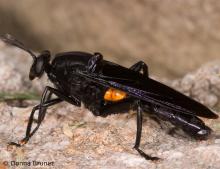
Species Types
Scientific Name
About 80 species in North America
Description
Mydas flies are quite large, and although they resemble wasps, they are harmless. Note that all true flies have only one pair of wings. Also note the clubbed antennae (unusual for flies).
Media
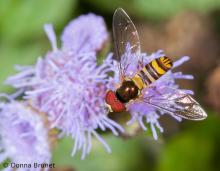
Species Types
Scientific Name
Nearly 900 species in North America
Description
Harmless flies and valuable pollinators, flower flies are incredibly convincing mimics of bees, wasps, and yellowjackets. Recognize them as true flies by their single pair of wings, short antennae, and flylike compound eyes.
Media
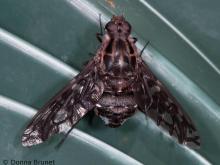
Species Types
Scientific Name
About 800 species in North America
Description
Resembling bees, or sometimes big, fuzzy mosquitoes, bee flies are a family of true flies and are not bees at all. Lacking the ability to sting, their bee mimicry helps them avoid many would-be predators.
Media

Species Types
Scientific Name
Trichopoda spp.
Description
Feather-legged flies are a genus in the tachinid fly family. They are beelike and have a feathery fringe of hairs on their hind legs, resembling the pollen basket of honeybees.
Media

Species Types
Scientific Name
Panorpa spp.
Description
Male scorpionflies will make you look twice, because the abdomen is tipped with what looks like a scorpion stinger! These nifty insects cannot sting, however.
Media

Species Types
Scientific Name
About 84 species in North America.
Description
Many blow flies are so shiny and colorful they’re called greenbottles and bluebottles. But pretty as they are, it’s hard not to be repulsed by their larval diets.
Media
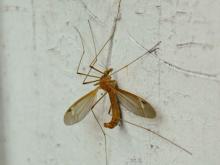
Species Types
Scientific Name
More than 500 species in North America north of Mexico
Description
Many people are frightened of crane flies, which resemble huge mosquitoes. But crane flies don’t bite or suck blood. In fact, as adults, most of them don’t have mouths at all!
Media
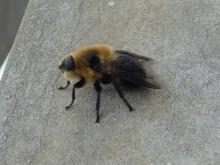
Species Types
Scientific Name
About 40 species in North America north of Mexico
Description
Bot flies are chunky, beelike flies usually with rounded heads. Adults are not commonly seen. The larvae are short, pudgy, segmented grubs that live as parasites in the tissues of animals. Those that live just under the skin often form a bulge. Some types live in the nasal or throat cavities of deer.
Media

Species Types
Scientific Name
Ommatius spp.
Description
Ommatius robber flies are medium-sized robber flies with distinctively branching antennae. There are about four of five species that might occur in Missouri.
Media

Species Types
Scientific Name
Anthrax georgicus
Description
The field coal bee fly, Anthrax georgicus, has no real common name. Look for it in grasslands, fields, and other open areas.
See Also



Media

Species Types
Scientific Name
Cisseps fulvicollis
Description
The yellow-collared scape moth is more often “orange-collared.” And whether you think it looks more like a firefly or a wasp, it’s still a moth!
Media

Species Types
Scientific Name
Nearly 150 species in North America north of Mexico
Description
Slim, delicate plume moths are instantly recognizable by their T-shaped silhouette, long legs, and muted shades of tan and brown. It can be hard to separate the various species.
Media

Species Types
Scientific Name
Pyrrharctia isabella
Description
Not many people know the adult Isabella tiger moth when they see one, but we’re all acquainted with its caterpillar, the woolly worm, or woolly bear.
About Land Invertebrates in Missouri
Invertebrates are animals without backbones, including earthworms, slugs, snails, and arthropods. Arthropods—invertebrates with “jointed legs” — are a group of invertebrates that includes crayfish, shrimp, millipedes, centipedes, mites, spiders, and insects. There may be as many as 10 million species of insects alive on earth today, and they probably constitute more than 90 percent all animal species.





















